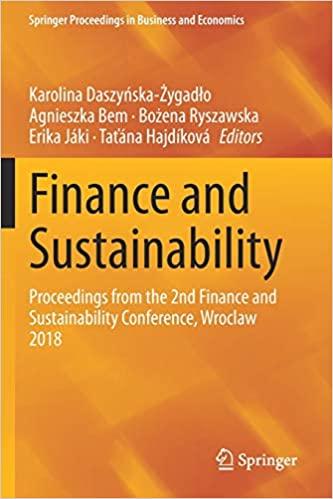Question
1. Which of the following references stock and bonds issued by corporations to raise capital for corporate expansion? a. Acknowledgements b. Stock and bond options
1. Which of the following references stock and bonds issued by corporations to raise capital for corporate expansion?
a. Acknowledgements
b. Stock and bond options
c. Funding agreements
d. Investment options
e. Securities
2. Janice Cullen, owner of a nationally renowned photography business, files a registration statement and prospectus with the SEC. Five days after she files the registration statement, she has a meeting with her top 10 clients (primarily business owners who usually seek Janice for marketing purposes). During this meeting, Janice distributes a red-herring prospectus. At the end of the meeting, Janice decides to sell securities to her 10 clients, as well as 30 other clients with whom she had been emailing, despite the SECs not having yet declared her registration statement effective. Consequently, the SEC takes Janice to court for selling securities before the effective date of registration. The court holds Janice liable for violating the 1933 Securities Act. But what if the facts of the case were different? Select each set of facts below that could change the outcome of the case.
a. Janices photography business was a registered non-profit, and focused on teaching art and photography in public schools. Her top 10 clients were owners of local charities.
b. Janice published a tombstone advertisement before meeting with her top 10 clients. They saw this advertisement and were eager to engage in business with Janice.
c. The 40 clients who bought the securities from Janice were accredited investors.
d. Janice sold the securities to the 40 clients 25 days after she filed her registration statement.
(multiple answers are right)
3. Which of the following is true regarding who may be considered an insider under the Securities Exchange Act of 1934
a. Only directors are considered insiders
b. Directors, officers, and anyone who receives private information regarding the trading of securities may be considered insiders
c. Any shareholder is considered an insider along with all directors and all employees
d. Only employees are considered insiders
e. Only directors, officers, and majority shareholders are considered insiders
Step by Step Solution
There are 3 Steps involved in it
Step: 1

Get Instant Access to Expert-Tailored Solutions
See step-by-step solutions with expert insights and AI powered tools for academic success
Step: 2

Step: 3

Ace Your Homework with AI
Get the answers you need in no time with our AI-driven, step-by-step assistance
Get Started


